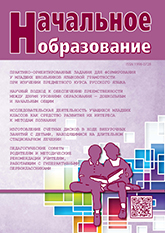Moskva, Moscow, Russian Federation
GRNTI 14.15 Система образования
GRNTI 14.25 Общеобразовательная школа. Педагогика общеобразовательной школы
The article gives advice to the teacher on the use of creative tasks in the process of working with younger schoolchildren in the classroom of visual arts, literary reading, music and the outside world. It is shown how when planning lessons one can take into account the specifics of the content of a school subject for constructing creative tasks based on the integration of the content of the topics studied.
younger schoolchild; subjects of the aesthetic cycle: literary reading, visual arts, music; lessons of the world; integration of the content of the studied topics; lesson planning; creative task.
Учебные предметы эстетического цикла – литературное чтение, музыка, изобразительное искусство, а также уроки окружающего мира создают особые условия для творческого развития младших школьников. Даже самые простые задания могут ставить ученика в ситуацию поиска творческого решения.
ПЛАНИРОВАНИЕ УРОКОВ С ВКЛЮЧЕНИЕМ СОДЕРЖАНИЯ
РАЗНЫХ УЧЕБНЫХ ПРЕДМЕТОВ
Рассмотрим примеры творческого подхода учителя начальных классов к планированию уроков на основе интеграции содержания изучаемых тем. Варианты объединения содержания разных предметов эстетического цикла, а также окружающего мира могут быть, например, следующими: На уроке изобразительного искусства при изучении темы «Смешивание красок» учащиеся знакомятся с тремя основными цветами: красный, желтый, синий. При смешивании синего и желтого цвета они получают зеленый. Затем учитель предлагает младшим школьникам попробовать получить фиолетовый или оранжевый цвет, выяснив, что произойдет, если смешать красную и желтую краски. Оказывается, получится цвет, о котором поется в известной песенке «Оранжевое небо» (композитор – К. Певзнер, стихи – А. Арканов). Проведенные опыты со смешением красок подводят детей к пониманию основных цветов, а также тех, которые получаются путем смешения красок. Дети решают творческую задачу, отвечая на вопросы: – Где в природе можно встретить тот или иной цвет? – При изображении каких объектов можно его использовать? Учащиеся вспоминают, что лиловый цвет, к примеру, в природе встречается довольно часто: это и растения, и грибы, и море в вечернее время, и грозовое небо…
1. Gorodetskaya Yu. Integrirovannye zanyatiya gumanitarno-esteticheskogo tsikla: metodika, soderzhanie, rekomendatsii [Integrated classes of the humanitarian-aesthetic cycle: methods, content, recommendations]. Moscow: Palmarium Publ., 2016. 56 p.
2. Dirksen Dzhuli. Iskusstvo obuchat’: kak sdelat’ lyuboe obuchenie neskuchnym i effektivnym [The art of teaching: how to make any training fun and efficient]. Dzhuli Dirksen [Julie Dirksen]. Moscow: Mann, Ivanov i Ferber Publ., 2013. 75 p.
3. Kemel’bekova G.A. Osobennosti formirovaniya funktsional’noy gramotnosti uchashchikhsya po predmetam gumanitarnogo tsikla [Features of the formation of functional literacy of students in the subjects of the humanities cycle]. Problemy i perspektivy razvitiya obrazovaniya: materialy VIII Mezhdunarodnoy nauchnoy konferentsii [Problems and prospects for the development of education: materials of the VIII International Scientific Conference]. Krasnodar: Novatsiya Publ., 2016, pp. 6-9.
4. Funktsional’naya gramotnost’ mladshego shkol’nika: didakticheskoe soprovozhdenie [Functional literacy of the younger student: didactic accompaniment]. Moscow: Rossiyskiy uchebnik Publ., 2018. 468 p.
5. Sharipova R.D. Soderzhanie navykov funktsional’noy gramotnosti mladshikh shkol’nikov v kurse literaturnogo chteniya [The content of functional literacy skills of younger students in the course of literary reading]. Mezhdunarodnyy studencheskiy nauchnyy vestnik [International Student Scientific Bulletin]. 2016, I. 5-2, pp. 8-16.






